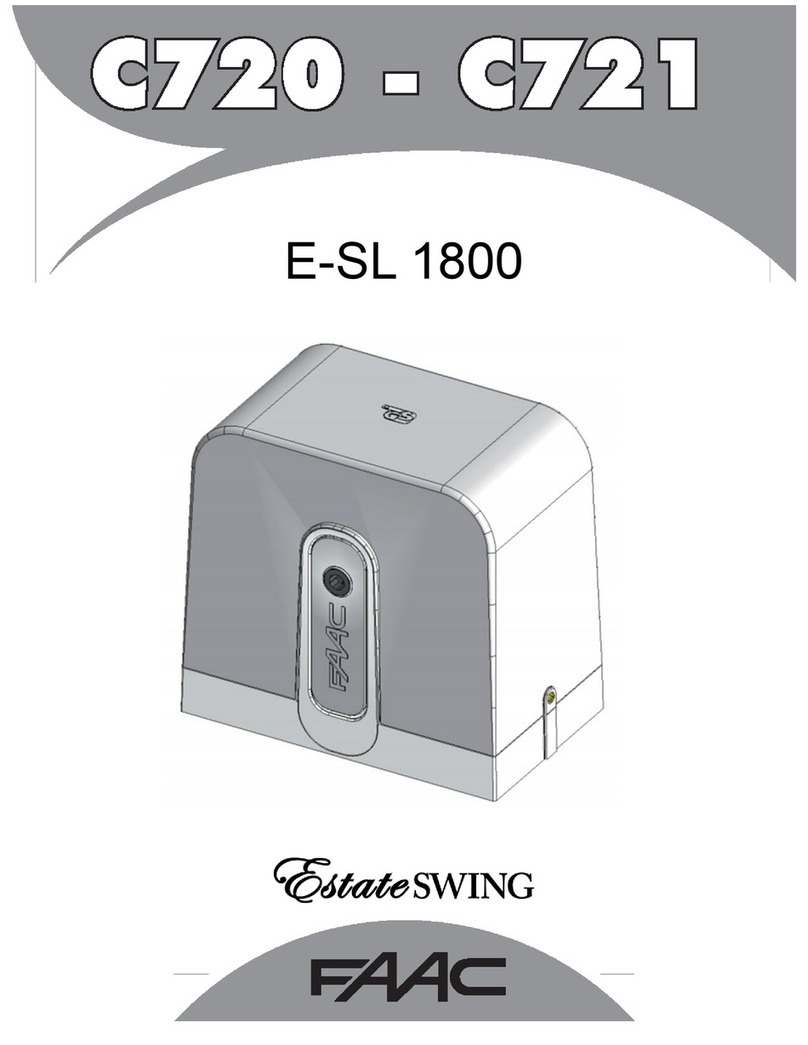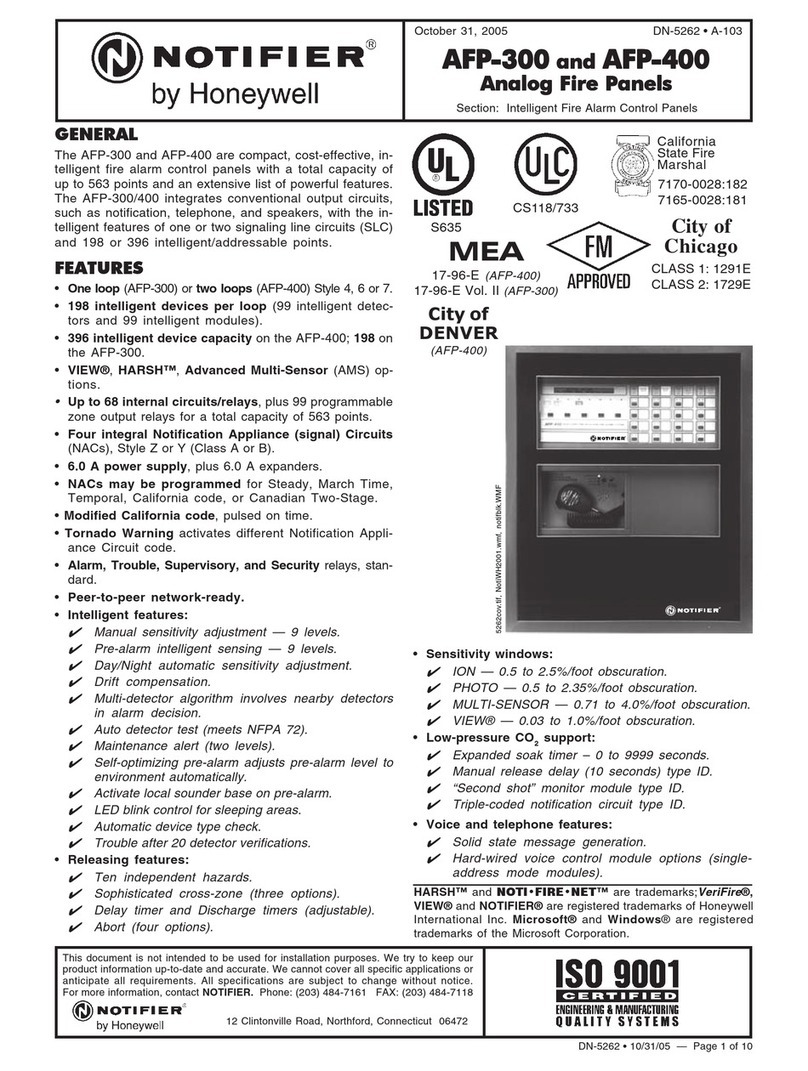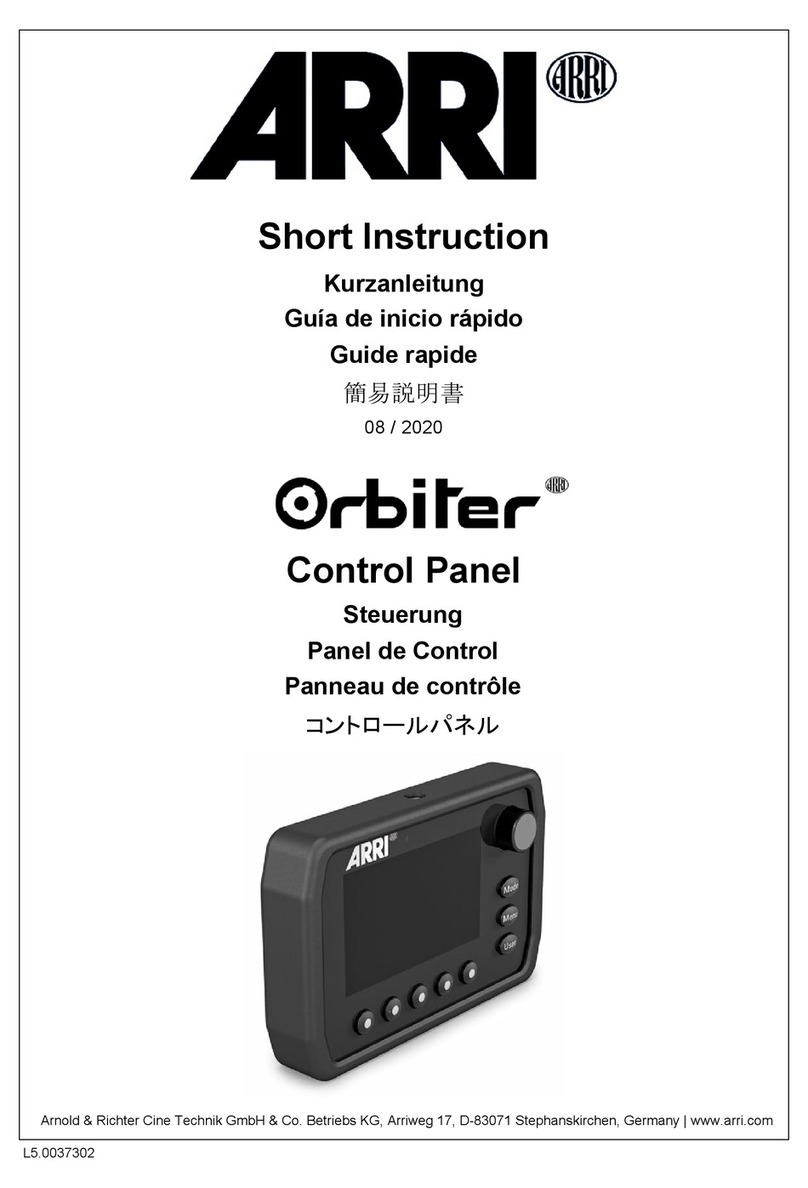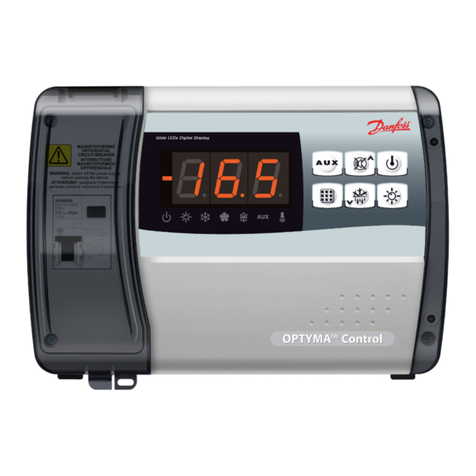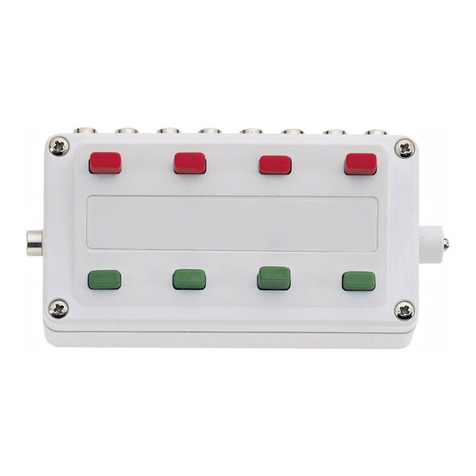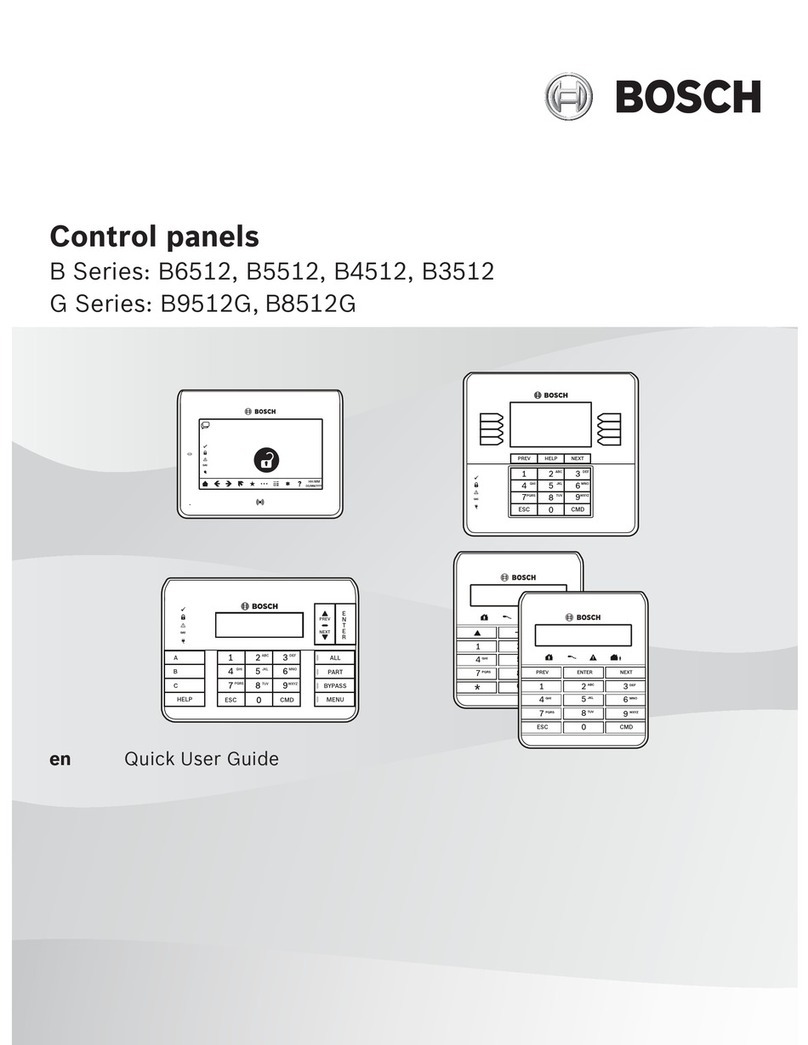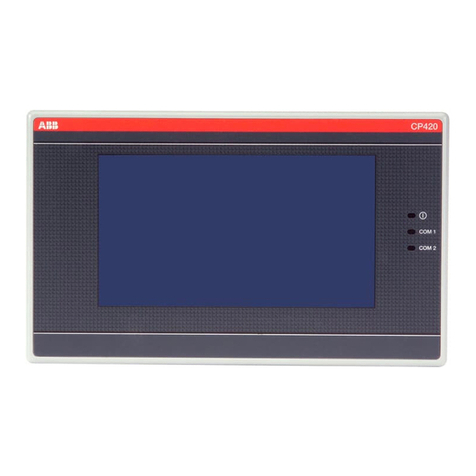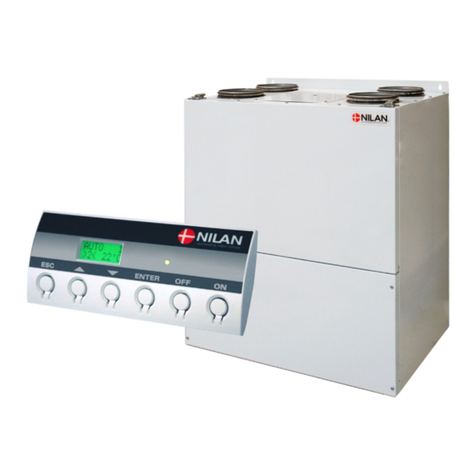Bartlett V6-CF User manual

Operation Manual
Model V6-CF
Controller
BARTLETT
INSTRUMENT COMPANY
1404 Avenue M
Fort Madison, IA 52627
319-372-8366
WWW.BARTINST.COM

WELCOME !! ...............................................................................................................................................3
PRECAUTIONS............................................................................................................................................3
CONTROLLER FRONT PANEL...............................................................................................................4
OVERVIEW OF HOW THE CONTROLLER FUNCTIONS .................................................................5
GETTING STARTED ..................................................................................................................................6
PROGRAMMING ........................................................................................................................................7
1. CONE FIRE ..........................................................................................................................................7
To use CONE FIRE: ...............................................................................................................................7
CONE FIRE Example .............................................................................................................................8
2. VARY-FIRE ..........................................................................................................................................8
VARY-FIRE Example ............................................................................................................................9
RECALL PROGRAM is used to recall a previously programmed firing profile. ..................................9
3. VIEW SECTION ...................................................................................................................................9
4. OPTIONS SECTION...........................................................................................................................11
Delay - This key is used to delay the start of a firing............................................................................11
Other – There are nine “Other” options. Pressing “Other” will continue to cycle through the options available, Rset
(reset), PrHt (Preheat), Id (identification), 16-S (16 segment), CnoS (Cone Offset) , CHG°(Change °F to °C), ErCd
(Error Codes), tCoS ( thermocouple offset ), bd t (board temperature), and LAG (Lag setting)..........11
ZONE CONTROL ......................................................................................................................................15
1. FEATURES AND INHANCEMENTS ...............................................................................................15
2. GENERAL DESCRIPTION ................................................................................................................15
3. ADJUSTABLE LAG ...........................................................................................................................15
4. THERMOCOUPLE OFFSETS ( see T/C offsets and Cone offsets in the OPTIONS SECTION for more information)
...................................................................................................................................................................15
5. THREE THERMOCOUPLES .............................................................................................................15
6. ERROR CODES (ErCd) or ERROR CHECKING ..............................................................................16
7. “Other” MENU - New zone features accessed using the “Other” button ..........................................16
APPENDIX A - CONE FIRE TEMPERATURE PROFILES..............................................................17
APPENDIX B - ERROR CODES...........................................................................................................17
APPENDIX C - COMMON QUESTIONS AND SITUATIONS...........................................................19
APPENDIX D - FIRING PROGRAM BLANK ....................................................................................19
APPENDIX E - CONNECTION DIAGRAM..........................................................................................20

WELCOME !!
Thank you for purchasing a Model V6-CF temperature controller. The Model V6-CF is an enhanced version of previous
controllers which have been offered. We hope this manual helps you learn to use your controller quickly and efficiently.
Additional information can be found on the internet at www.bartinst.com
FEATURES
∗ Firing methods and features which make firing easier:
• CONE FIRE METHOD - Used to fire to a specific cone number using one of four speeds, “Slow Bisque”, “Fast
Bisque”, “Slow Glaze”, or “Fast Glaze”.
• VARY-FIRE PROGRAMMER - Program up to 6 separate firing profiles for repeated use. Each profile may have
up to 8 segments with separate heating or cooling rates, temperature set-points, and hold times.
• DELAY START - Delay the start of your firing up to 99 hours and 99 minutes.
• PREHEAT - Used with CONE FIRE mode to hold at a temperature of 200 °F for a specified time then go
automatically into the cone fire program. This can be used for drying ware.
• ALARM - User set audible temperature alarm.
∗ Advanced features:
• CONE OFFSET - Used to raise or lower the final temperature of any cone to fine tune the controller to your kiln.
• SKIP STEP -Skip from the present segment to the next ramp.
• ERROR CODES - Error codes may be turned on so the kiln will automatically shut down if there is an error.
• 16 SEGMENT PROGRAMS – User 5 and 6 can be combined for a 16 segment program.
∗ Messages and information:
• REVIEW PROGRAM - Review your firing profile any time before or during the firing.
• VIEW SEGMENT - View the current segment, set-point, board temperature, or skip to the next segment.
• CONE TABLE - Easily look up temperature and cone number equivalents.
•Choose between FARENHEIT or CELCIUS temperature scales.
* Communicates with personal computer equipped with KISSsoftware.
Precautions
The controller is used to control temperature, it is not a safety device.
Do not operate the controller in temperatures above 125 °F.
Never leave your kiln unattended at the end of a firing.
The controller contains electronic components which are sensitive to static electricity. Before handling the controller dissipate
any static charge you may have by touching metal or a screw on the controller panel, the electrical box, the kiln lid, or some
other grounded object.
Always check the position of the thermocouple probe before starting a firing. The current temperature displayed on the
controller is measured at the end of the thermocouple which must be in the firing chamber
Always review the current program before firing to ensure the correct profile is programmed.

Controller Front Panel
On the following pages the individual sections of the controller front panel will be explained in
more detail.
Start-Stop button
for starting and
stopping firings.
LED DISPLAY -
four digit display
showing times and
temperatures.
VARY-FIRE
Programmer for
setting and saving
your own firing
profiles
OPTIONS section
for setting delay
start and alarm. Set
one of nine “Other”
options: Default
reset, Preheat stage
time, Controller ID,
16 segment
program, Cone
offset, Change °F to
°C, set Error codes
off, set T/C offset,
check board
temperature.
Number keys
section for
entering
temperatures and
times.
CONE FIRE
section for
choosing one of
four preset cone
fire speeds.
VIEW section to look up cone temperatures, review
the selected program, view the current segment, or
skip to the next firing segment.

Overview of How the Controller Functions
You enter a program that tells the controller what temperature you want to fire to and at what rate you want the temperature to
rise. The controller uses a thermocouple (t/c) to sense the temperature in the kiln. The temperature is measured at the tip of
the t/c so it is important that the tip be 1½" to 2" inside the kiln wall. When “START” is pressed, the controller reads the kiln
temperature and uses that temperature as a starting point for a traveling set-point (also called the local set-point). The
controller then calculates how much power is needed to keep the temperature equal to the traveling set-point and cycles the
electricity to the elements so the correct amount of power is applied. As the firing progresses, the controller moves the
traveling set-point according to the programmed firing rate and recalculates how much power is needed to keep the
temperature at the new traveling set-point. This sequence continues until the final temperature is reached and the controller
turns off the kiln. For the controller to turn off the kiln both the temperature and the set-point must reach the final temperature.
There are two programming modes or methods. The cone fire method is the easiest to program and it is designed for firing
ceramics to ensure correct heat-work for each cone number and firing rate. The final temperature is adjusted up or down based
on the final heating rate to ensure the correct heat-work. The vary-fire mode allows more complicated profiles and more firing
freedom. Vary-fire programs contain up to 8 segments each segment containing a heating rate to a certain temperature and a
hold time. Vary-fire programs are used for firing such things as glass, jewelry, and crystalline glazes.

Getting Started
Read all precautions before using your controller.
If your kiln has individual manual controls for each heating element, turn all the dials to HIGH.
If your kiln has a manual shut-off device, use one higher cone number than you are firing to in the device. If there is a timer,
set it for longer than the estimated firing time.
Before starting a firing press the Review Program button to ensure the correct program is ready to fire.
Plug your kiln into an electrical outlet. Applying power to the controller causes either the current temperature or "ErrP" (Error
Power) to be displayed. Press the "1" key to change the “ErrP” display to the current temperature. The microprocessor in the
controller is checking various settings so it will take several seconds before the display changes to the current temperature.
When the current temperature is flashing, you may program the controller for a firing or you may choose one of the other
available options.
IMPORTANT PROGRAMMING NOTE: Before initiating a firing profile or performing any other function, the current
temperature must be flashing. Pressing the “1” key will clear the display of errors (Err) or FAIL.
In most cases when programming, you will choose an option, then press ENTER to accept the option. After programming is
complete press the START/STOP button to begin the firing.
With the display flashing IdLE alternating with the current temperature, you are ready to proceed to one of the programming
sections.
The CONE FIRE mode uses Orton’s patented method to achieve correct heat-work so it is ideal for firing ceramics. The
advantage of using the CONE FIRE method is that a very complicated firing profile may be chosen with just a few key strokes.
The CONE FIRE method helps protect against over and under firing by carefully tracking and controlling the temperature at
the end of the firing as the cone temperature is approached. The final temperature is adjusted according to the final firing rate.
For example, as the heating elements age and the heating rate slows, the final temperature will be adjusted downward to ensure
the correct amount of heat-work.
The VARY-FIRE mode can be used for ceramics, glass, jewelry, glazes, decals, etc. It allows you to create your own firing
profiles which can be saved and used over and over.
AT THE END OF A FIRING:
When the firing is complete, CPLt, the firing time, and the current kiln temperature alternately are displayed. Press ENTER or
START/STOP to return to IdLE. If you want to save the firing time, you must write it down; it is not retained in
memory.
Pressing Review Program, immediately after a cone fire program is complete and back to IdLE, will show the actual
temperature which was reached. The temperature is displayed after °F.

PROGRAMMING
1. CONE FIRE
The CONE FIRE mode allows you to fire to a cone number with one of four different speeds.
To use CONE FIRE:
1. Make sure the temperature is flashing. Pressing the “1” key will clear the display of errors (Err) or FAIL.
2. Press one of the 4 firing speed buttons (see appendix A to see the ramp speeds)
3. Press ENTER
4. Type the cone number you want (acceptable values are from 022 to 10).
If you type a wrong number, press zero 3 times or until all zeros appear in the display, press ENTER, then type the
correct number (only three digits are displayed at this time)
5. Press ENTER.
6. Type the hold time if you want to hold at the end of the firing or leave at zero
7. Press ENTER. CPL will be displayed briefly, then the current temperature will be flashing in the display.
8. Press START/STOP to begin firing.
NOTE: With any of the CONE FIRE modes, a preheat stage is available. During the preheat stage the
temperature is increased at a rate of 60 °F per hour until 200 °F is reached; the 200°temperature is then held for the
programmed amount of time. Preheat is automatically set to zero during cone fire programming and at the end of each
firing, so if a preheat stage is wanted, it must be reprogrammed before each cone firing. See SECTION 4 –
“OTHER” options for programming “Preheat”.
Slow
Bisque
Fast
Bisque
Slow
Glaze
Fast
Glaze
Slow Bisque - Used for setting a slow bisque firing profile.
** 13 hours to fire to cone 04.**
Fast Bisque - Used for setting a fast bisque firing profile.
** 10 hours to fire to cone 04.**
Slow Glaze - Used for setting a slow glaze firing profile.
** 7 hours to fire to cone 04.**
Fast Glaze - Used for setting a fast glaze firing profile.
** 4 hours to fire to cone 04.**

CONE FIRE Example
Slow Bisque Firing,Pre-heat 1 hour, Cone 04, 10 minute Hold - Use the following steps for a bisque firing to cone 04, a 10
minute temperature hold at the peak temperature, and a preheat stage with 1 hour hold time.
Step Press Display Comment
1 Slow Bisque S-bC If you press the wrong button, before pressing ENTER, simply press
the correct button.
2
ENTER
alternately flashing:
ConE & No.
Slow Bisque is now selected. The word ConE and the last entered
cone number will alternately flash on the display. Now enter the
cone number - 04.
3
0, 4
alternately flashing:
ConE & 04
The word ConE and the entered cone number will alternately flash
on the display. If you type a wrong number, press zero 4 times, then
type the correct number.
4
ENTER
alternately flashing:
HLd & 00.00
The cone number has been accepted. Now enter the 10 minute hold
time.
5
1, 0
00.10
Numbers to left of decimal point are hours, to the right of decimal
point are minutes. If you type a wrong number, press zero 4 times,
then type the correct number.
6 ENTER CPL flashes, then the
current temperature
The 10 minute hold time is accepted. CPL indicates the firing profile
has been completed. Steps 7 through 10 set the preheat option.
7 Other until
PrHt displayed
PrHt Press Other until PrHt is displayed. If you accidentally pass PrHt
press “other” several more times until PrHt appears again.
8
ENTER
alternating flashing:
HLd & 00.00
Preheat has been selected and the hold time is to be entered now.
9
1, 0, 0
01.00
Numbers to left of decimal point are hours, to the right of decimal
point are minutes. NOTE: For a 1 hour hold time you could also
enter 60 for 60 minutes; the display would show 00.60. If you type a
wrong number, press zero 4 times, then type the correct number.
10
ENTER
CPL flashes, then current
temperature
Accepts a hold time of 1 hour, then CPL indicates the preheat stage
has been completed.
11
START/STOP
-On-
After -On- is displayed for several seconds, the heating elements of
the kiln will cycle on and the current temperature in the kiln will be
displayed.
If a time is displayed instead of the current temperature, then a delay
start is in effect. If you do not want to delay the start. Press
START-STOP button, then Delay, then 0000, ENTER. When the
current temperature again flashes in the display, press START-
STOP.
2. VARY-FIRE
The V6-CF has 6 vary-fire user programs to store and reuse. Each program has from 1 to 8 segments (2 – 16 segments if 16-S
option is on). Each segment has a firing rate, a soak temperature, and a hold time. It is best to write out the firing profile that
you plan to program before you begin programming. To ramp at the maximum rate either up or down, enter a rate of 9999. To
program a down ramp, you enter the rate/hour then a temperature below the previous segment temperature.
NOTE: The first ramp rate of any user program must be an increasing ramp which means the segment temperature
must be greater than the starting kiln temperature.
The following example is a two segment program stored in memory location “user 1”.
Segment Rate °F/hour Temperature Hold
1 100 200 0
2 500 1575 0
NOTE: At the end of the Operation Manual there is a blank form for writing your firing programs. Photo-copy as needed.

VARY-FIRE Example
The following steps are used to program User 1 program for the firing profile above.
Step Press Display Comment
1 ENTER
PROG
alternately flashing:
USEr & No.
The display alternates between USEr and the last selected
user number.
2 1 1 Selects user (USEr) profile number 1
3 ENTER alternately flashing:
SEG & No.
The displays flashes between SEG and the number of
segments which were previously programmed
4 2 2 This is the number of segments needed for our example
5 ENTER Alternately flashing:
rA 1 & No.
The display flashes between rA 1 and the heating rate per
hour that was previously programmed
6 1, 0, 0 0100 Displays the selected rate/hour
7 ENTER Alternately flashing:
°F 1 & No.
The display flashes between °F 1 & the temperature
previously programmed
8 2, 0, 0 0200 displays the selected temperature
9 ENTER Alternately flashing:
HLd1 & No.
The display flashes between HLd 1 & the hours and
minutes which were previously programmed.
10 0 00.00 If display does not show 00.00, press 0 until 00.00 is
displayed.
11 ENTER Alternately flashing:
rA 2 & No.
The display flashes between rA 2 & the heating rate
previously programmed.
12 5, 0, 0 0500 Displays the selected rate/hour
13 ENTER Alternately flashing:
°F 2 & No.
The display flashes between °F 2 & the temperature which
was previously programmed
14 1, 5, 7, 5 1575 Displays the selected temperature
15 ENTER Alternately flashing:
HLd2 & No.
The displays flashes between HLd2 & the previously
selected hold time.
16 0 00.00 No hold time.
17 ENTER Alternately flashing:
ALAr & No.
The display alternates between ALAr & the previously
used alarm setting.
18 9, 9, 9, 9 9999 Enters the temperature at which the alarm will sound. The
alarm will be turned OFF with a setting of 9999.
19 ENTER CPL flashes then the
current temperature
CPL flashes several times indicating the program has been
completed. The current temperature then flashes in the
display.
RECALL PROGRAM is used to recall a previously programmed firing profile.
Example: To recall user program #5, use the following:
Step Press Display Comment
1 RECALL
PROG
Alternately flashing:
USEr & 1
The controller is ready to accept the desired user number.
2 5 5 Indicates the user program selected.
3 ENTER CPL flashes then the
current temperature
CPL flashes several times indicating the program has been selected. .
The current temperature then flashes in the display.
3. VIEW SECTION
View Section - Contains buttons to look up cone temperatures, review programs, view current segment, and skip
segments during Vary-Fire Programs.
Review
Program
View
Segment
Cone
Table
The view section allows you to view various
information about cone temperatures, firings and
settings.

Cone Table - Used to look up the temperature of various cone numbers. The temperature which is displayed is for
self-supporting cones with a heating rate of 108°F/hr. To use, press Cone Table, enter the cone number you
want to look up, press ENTER; the cone temperature will be displayed followed by CPL.
Review Program - The information displayed when Review Program is pressed varies depending on whether you
are using Cone Fire or Vary Fire. When Review Program is pressed, each of the steps in the current firing
profile is displayed one after another changing every ½ second.
In Cone Fire Mode - The display will show the selected firing profile in the following order:
Cone fire speed
preheat time (PrHt)
cone # (ConE)
cone temperature* (°F)
hold time (HLd)
delay time (dELA)
alarm setting (ALAr)
error codes on/off (ErCd)
LAG setting (if zone control)
* After a firing is complete, the cone temperature (°F) will show the actual temperature reached
during the firing.
In Vary Fire Mode - The display will show in the following order:
the user program # (USEr)
the number of segments (SEG)
1st ramp rate (rA 1)
1st segment temperature (°F 1)
1st hold time (HLd1)
(If there is more than 1 segment, then the ramp rate, segment temperature, and hold time of
each of the other segments will be displayed in order.)
delay time (dELA)
alarm setting (ALAr)
error codes on/off (ErCd)
LAG setting if zone control
View Segment - only functions when a firing is in progress. View segment is used to view the current firing
segment or to skip from the current segment to the next firing ramp. When View Segment is pressed during
a firing the current segment of the firing, the travelling set-point and the circuit board temperature are
displayed. If it is pressed during IdLE, StOP is displayed then the current temperature.
Skip Step (SStp) - Skip Step (Skip Step) is included in View Segment. The skip step feature is only
available in a VARY-FIRE firing profile. It is used when enough heat work has been done at the current
segment and you want to immediately go the next ramp rate. To skip to the next ramp, press View Segment,
then within ½ second, press ENTER, and ENTER a second time. If you press View Segment and do not
press ENTER within ½ second, the current segment (e. g., rA 1) will continue to be displayed. Simply wait
until the temperature is again displayed and press View Segment, then ENTER within ½ second, and
ENTER again. If you press View Segment, then ENTER, then decide not to skip to the next ramp stage,
simply do not press any key; after about 10 seconds the display will return to the current temperature.

4. OPTIONS SECTION
Delay - This key is used to delay the start of a firing.
Example: Program a one hour delay to the start of a firing.
Remember: the temperature must be flashing before beginning to program.
Step Press Display Comment
1 Delay Alternately flashing:
dELA and 00.00
The controller is ready to accept the delay time of 1 hour.
2
1, 0, 0
01.00
Displays the selected time. Numbers to left of decimal point are
hours, to the right of decimal point are minutes. If you type a
wrong number, press zero 4 times, then type the correct number.
3
ENTER
CPL flashes then the current
temperature
CPL flashes several times indicating the 1 hour delay has been
accepted. The current temperature then flashes in the display.
Alarm - This key is used to set the high or low temperature alarm. The alarm may be set before or during a firing.
When the alarm temperature is reached, a buzzer will sound.
Example: Before the start of a firing, set the alarm temperature to go off at 200°F.
Remember: the temperature must be flashing before beginning to program.
Step Press Display Comment
1
Alarm
Alternately flashing:
ALAr and #
The word ALAr and the last entered alarm temperature will
alternately flash on the display. The controller is ready to accept the
alarm temperature. If no alarm is entered within 10 seconds, the
display will flash CPL and then the current temperature.
2 2, 0, 0 0200 Displays the selected temperature of 200°. If you type a wrong
number, press zero 4 times, then type the correct number.
3 ENTER CPL flashes then the
current temperature
CPL flashes several times indicating the alarm temperature has been
accepted. The current temperature then flashes in the display.
Other – There are nine “Other” options. Pressing “Other” will continue to cycle through the options
available, Rset (reset), PrHt (Preheat), Id (identification), 16-S (16 segment), CnoS (Cone Offset) ,
CHG°(Change °F to °C), ErCd (Error Codes), tCoS ( thermocouple offset ), bd t (board
temperature), and LAG (Lag setting).
NOTE: PrHt (Preheat) will not appear in this menu unless a CONE FIRE mode has been selected. 16-S will not appear
unless User 5 is the selected program.
TO EXIT this menu without selecting any option, cycle through by pressing “Other” until CHG°appears, then
press ENTER twice.
rSEt (RESET) - press “OTHER” until rSEt is displayed, then press “ENTER”. CPL will be displayed indicating
that the T/C offsets have been set to zero, the LAG to 13, and the error codes are turned ON.
PrHt (Preheat) - Preheat is used with the CONE FIRE mode only. When Preheat is in used, the temperature ramps
up at 60°F/hour to 200°F and then holds at 200°for the amount of time programmed. So if you start at a room
temperature of 70°F, then it will take just over 2 hours to reach 200°F at which time the hold time will start. Preheat
is automatically set to zero during cone fire programming and at the end of each firing. If a preheat stage is desired, it
must be reprogrammed for each firing.

Preheat Example: Set a preheat time of 2 hours. Remember: the temperature must be flashing to start the
programming.
Step Press Display Comment
1
Other
PrHt
If PrHt does not show on the display, even after cycling through the
options, it means that CONE FIRE mode has not been selected. Exit the
menu and select a CONE FIRE speed, then return to the Other menu.
2
ENTER
Alternately flashing:
HLd & 00.00
Preheat has been selected; enter the time you want to hold the temperature
at 200°F (in this ex. 2 hours)
3
2, 0, 0
02.00
Displays the selected time of 2 hours. Numbers to left of decimal point
are hours, to the right of decimal point are minutes. If you type a wrong
number, press zero 4 times, then type the correct number.
4
ENTER CPL flashes then the
current temperature
CPL flashes several times indicating the 2 hour preheat time has been
accepted. The current temperature then flashes in the display.
Id ( identification # ) Used by KISS (Kiln Interface Software System) to identify the kiln when hooked to a
personal computer. This is covered in a separate KISS manual.
16-S ( 16 segment program ) This option allows vary-fire programs 5 and 6 to be combined into a 16 segment
program. It only shows in the menu when user 5 is programmed and selected. When using this option user 5
and 6 programs can have 1 to 8 segments. First, program user 5 then user 6. Next, recall user 5 and then use the
Other key to display “16-S”. Press ENTER to accept the option. Press “1” until the display shows"On". Press
ENTER to activate the 16 segment option. Press Start and the controller will fire user 5 then it will fire user 6.
NOTE: The first segment of user 6 must be an up ramp or the segment will be skipped.
CnoS (Cone Offset) - Used to raise or lower the final cone temperature. The final cone temperature can be raised or
lowered a maximum of 50°F (28°C).
When entering the offset temperature the following convention is used: the left two digits designate whether
to raise (00) or lower (90) the cone temperature, that is, “00” means plus (+) and “90” means minus (-). The
right two digits are the number of degrees the cone temperature will be raised or lowered.
Examples:
Number Meaning
0020 Raise the final cone temperature by 20°F increases heat work
0040 Raise the final cone temperature by 40°F increases heat work
0015 Raise the final cone temperature by 15°F increases heat work
9030 Lower the final cone temperature by 30°F decreases heat work
9005 Lower the final cone temperature by 5°F decreases heat work
9045 Lower the final cone temperature by 45°F decreases heat work
The following apply to cone offsets:
The final temperature is affected only for the cone number that you change and no other cone numbers.
The cone offset will remain for that specific cone number until it is changed again.
Typing 00 (before the desired offset temperature) will raise the final temperature and INCREASE the amount of heat
work.
Typing 90 (before the desired offset temperature) will lower the final temperature and DECREASE the amount of
heat work.
The maximum number of degrees that can be raised or lowered is 50°F (28°C)
Cone offsets do not affect the VARY-FIRE mode.
Cone Offset Example: Adjust cone 07 to shut off the kiln at 20°F below Orton’s prescribed cone temperature.

Step Press Display Comment
1 Other,
Other
CnoS If CnoS does not show on the display, press the Other key until CnoS displays.
2 ENTER Alternately flashing:
ConE & #
Cone Offset has been selected; the word ConE and the last entered cone
number will alternately flash on the display. Now enter the cone number which
you want to adjust (in this example cone 07)
3 0, 7 Alternately flashing:
ConE & 07
The word ConE and the entered cone number (07) will alternately flash on the
display. If you type a wrong number, press zero 3 times, press ENTER, then
type the correct number.
4 ENTER Alternately flashing:
°F0S & 9000
°F OS and the previous offset setting alternately flash. Enter the new offset
temperature using the rules above, in this example, “9020”.
5 9, 0, 2, 0 9020 The selected offset temperature is displayed. If you type a wrong number,
press zero 4 times, then type the correct number.
6 ENTER CPL flashes then the
current temperature
CPL flashes several times indicating the offset temperature adjustment has been
accepted. The current temperature then flashes in the display.
tCoS (Thermocouple Offset) - Used to raise or lower the temperature indicated by the thermocouples. The
maximum offset is 50°F (28°C). A positive offset is entered with 00 preceding the amount of offset and a
negative offset is preceded by 90. This is the same as is done for entering cone offsets. A negative offset will
lower the indicated temperature reading and cause more heat-work. When tCoS is displayed, press ENTER
and the current offset for the thermocouple will be displayed. Press ENTER when the correct offset is
displayed.
The following apply to T/C offsets:
The final temperature is affected for all CONE FIRE and all VARY-FIRE programs.
The thermocouple offset will remain for that T/C until it is changed again.
Typing 00 (before the desired offset temperature) will raise the indicated temperature but it will lower
the actual temperature in the kiln and LOWER the amount of heat work.
Typing 90 (before the desired offset temperature) will lower the indicated temperature but it will
increase the actual temperature in the kiln and INCREASE the amount of heat work.
The maximum number of degrees that can be raised or lowered is 50°F (28°C).
CONE Offset T/C Offset
To Correct Under-firing Set positive (00) cone
offset
Set negative (90) t/c offset
To Correct Over-firing Set negative (90) cone
offset
Set positive (00) t/c offset
CHG °- Used to select degrees Fahrenheit (°F) or degrees Celsius (°C).
Example: Change from °F to °C.
Step Press Display Comment
1 Other, Other CHG°If “CHG°” does not show on the display, press the “Other” key until “CHG°”
displays.
2 ENTER °F Indicates that the Fahrenheit (°F) scale is being used. You can toggle back and
forth between °F and °C by pressing the “1” key.
3 1 °C . Displays “°C .”. The decimal point in the lower right corner means that the Celsius
(centigrade) scale has been selected.
4
ENTER
CPL flashes then
the current
temperature
CPL flashes several times indicating the temperature scale has been changed. The
current temperature in °C then flashes in the display. There will be a decimal point
in the lower right-hand corner of the display.

ErCd - Used to turn on or turn off the error codes. When you receive your controller the error codes are turned on. In
most cases, you want the error codes on to protect your firings. They can be turned off if you are doing special
firings, such as jewelry or glass firing where the kiln is left open.
NOTE: When ErCd is turned OFF. When errors are off, Err6 (t/c backwards) is still on. In cone fire mode during
the last segment (i., e., the last 250 degrees) of the firing, Err1 (ramping too slow ) and Err8 (temperature
falling) are turned on. Error Codes “off” also turns the “LAG” feature off.
Example: Turn the error codes off.
Step Press Display Comment
1 Other, Other ErCd If “ErCd” does not show on the display, press the “Other” key until
“ErCd” displays.
2 ENTER On Indicates that the error codes are turned on. You can toggle back
and forth between on and off by pressing the “1” key.
3 1 OFF Displays “OFF” indicating the error codes will be turned off.
4 ENTER CPL flashes then the current
temperature
CPL flashes several times indicating the error codes are off. The
current temperature then flashes in the display.
bd t (circuit board temperature) – Press enter when “bd t” is displayed and the circuit board temperature will be
displayed. It is used for diagnostics. If FAIL is displayed indicating a failed thermocouple (t/c), press the Other
key until “bd t” is displayed, press ENTER. If the t/c is faulty then the displayed temperature will be
approximately room temperature. If the circuit board has failed then FAIL will continue to be displayed.
Hot Keys while the kiln is firing.
#5 Key - pressing the number 5 key will show the calculated rate of rise. If the kiln has been on for less than 8
minutes, the display will show the programmed rate of rise and not the actual rate.
#8 Key - pressing the number 8 key will cause three of the display decimal points to act as pilot lights for the
elements. The thousands decimal point will light when the top element is on, the hundreds decimal point
will light when the middle elements are on, and the tens decimal point will light when the bottom elements
are on. When you have a single zone control kiln (one thermocouple) the decimal points will light in
unison although there might be some slight variation when each of the decimals come on.

ZONE CONTROL
1. FEATURES AND INHANCEMENTS
• 3 separately controlled zones ( 3 t/c inputs, 3 outputs )
• Adjustable offsets for each thermocouple (t/c)
• Continues to fire with 1 or 2 failed thermocouples (t/c’s)
• Suspend ramping when any zone lags the set-point
• Reset function which zeros the t/c offsets, turns the errors on, and sets the lag to 13 degrees
• Decimal points in the display can be used as pilot lights
Press the “8” key during a firing and the 1000’s decimal point will light when the top elements are on, 100’s
decimal point when middle elements are on, and 10’s decimal point when the bottom elements are on.
2. GENERAL DESCRIPTION
The V6-CF advanced 3-zone control system is programmed the same as the single zone control but it has new
features to ensure even firing from the top to the bottom of the kiln. A 3-zone control has 3 temperature sensor inputs
(thermocouples) and 3 independent outputs so the kiln can have 3 separately controlled sections (zones). The
controller senses the temperature in each section of the kiln, compares the temperature to the desired temperature
(traveling set-point) and adjusts the power going to each section separately giving each just the right amount of power
to keep the temperature at the correct setting. The single zone controller only measures the temperature at the center
of the kiln and gives all sections the same amount of power.
3. ADJUSTABLE LAG
For tighter control from one section to the next, the controller has a programmable “lag” feature so the user can set
how much the temperature in any zone can lag behind the traveling set-point. The maximum lag setting is 99, the
default setting is 13. The controller senses when any section is lagging behind the traveling set-point and keeps the
controller from increasing the traveling-set point until the lagging section catches up. Ramping of the traveling set-
point is only suspended when a section is behind by more than the programmed “lag”. A smaller “lag” will result in
tighter control between the sections but it will increase the firing time. “rSEt” will set the “lag” to 13. Therefore,
anytime a section is more than 13 degrees behind the traveling set-point the controller will wait for the lagging section
to catch up before increasing the traveling set-point. Turning error codes (ErCd) off will also turn off the lag feature.
4. THERMOCOUPLE OFFSETS ( see T/C offsets and Cone offsets in the OPTIONS
SECTION for more information)
Normal variation in thermocouples (t/c) can cause a section to fire too hot or too cool. The zone control has an offset
feature to adjust the reading of each thermocouple to compensate for any error. For example, if shelf cones indicate
that the bottom section is under firing, it means that the controller thinks the bottom section actually reached the
ending temperature when it really was below the ending temperature. To correct this problem, a negative
thermocouple offset is required. This offset will be subtracted from the actual reading and will lower the temperature
reading in that section. A negative offset will cause a section to fire to a higher temperature increasing the heat-work
for that section. A positive offset will cause a section to fire to a lower temperature decreasing the heat-work for
that section. “rSEt” in Other menu will return all the t/c offsets to 0.
5. THREE THERMOCOUPLES
Besides better measuring of the temperature, the zone control also offers security through its three thermocouples.
With a single zone controller, a firing will be stopped if the thermocouple (t/c) fails. The zone control with 3 t/c’s,
will continue to fire if one or two of its thermocouples fail during a firing. If the top or bottom thermocouple fails
that section will be controlled by the middle t/c. If the middle thermocouple fails the middle section will be controlled
by the top t/c. If at “IdLE” and a t/c fails, the display will alternate between FAIL and the number of the failed t/c
(1,2,3). The temperature of each zone can be viewed. The temperature will alternately flash with the currently
selected zone. To select zone 1, press the “1” key and tC 1 will alternate with the current zone 1 temperature. For
zone 2 press the “2” key, for zone 3 press the “3” key.

6. ERROR CODES (ErCd) or ERROR CHECKING
The zone control has the same standard error checking features of the single zone controller. Errd was introduced to
monitor whether any zone or section gets more than 100 degrees above the travelling set-point but this feature also
functions with the single zone controller. Errd may be triggered with a zone control if a thermocouple is in the wrong
section, there is crossed output wiring, or a relay is stuck on. Errd may be triggered in a single zone controller if there
is a stuck relay or a stuck output.
Turning error codes off with the zone control also turns the “lag” feature off. “rSEt” turns error checking on.
Caution should be taken when choosing to turn the errors off because it leaves the kiln vulnerable to malfunctions that
would normally be detected by the error codes.
7. “Other” MENU - New zone features accessed using the “Other” button
There are ten functions accessed through the “Other” button - reset (rSEt), preheat (PrHt), identification number (Id),
16 segment program (16 – S), cone offset (CnoS, change temperature scales (CHG°), error codes on/off (ErCd),
thermocouple offsets (tCoS), LAG setting (LAG), and board temperature (bd t).
NOTE: The “other” functions can only be accessed when the kiln is at Idle.
RESET (rSEt) press “OTHER” UNTIL rSEt is displayed then press “ENTER”. CPL will be displayed indicating
that the T/C offsets have been set to zero, the LAG to 13, and error codes (ErCd) set to “on”.
PREHEAT (PrHt) , CONE OFFSET (CnoS), CHANGE F/C (CHG°)all work as described in the OPTIONS
SECTION under Programming.
ERRORS ON/OFF (ErCd) (also referred to as error checking) works as described in the previous section but it will
also turn off the LAG (suspend ramping) when errors are turned off.
T/C OFFSETS (tCoS) (see also OPTIONS SECTION under Programming) are used to raise or lower the
temperature indicated by any of the thermocouples. The maximum offset is 50°F (28°C). A positive offset is entered
with 00 preceding the amount of offset and a negative offset is preceded with 90. The use of 00 for "+" and 90 for "-"
is the same as is done for entering cone offsets. A negative offset will lower the indicated temperature reading and
cause more heat-work. A positive offset will increase the indicated temperature reading and decrease heat work.
When tCoS is displayed, press ENTER and tC 1 will be displayed. Press enter and the current offset for the top
thermocouple will be displayed. Enter the offset you want then press ENTER and tC 2 will be displayed. Repeat the
above steps for tC 2 and tC 3.
LAG is the number of degrees any zone can lag the travelling set-point before ramping is suspended. Ramping will
continue as soon as the slow zone catches up. LAG is programmable with a maximum setting of 99. A smaller LAG
gives tighter control but usually slows the ramp rate because the local set point will only advance as fast as the
slowest zone. Reset programs LAG to 13.
bd t will indicate the temperature of the circuit board and is also used for diagnostics.

APPENDIX A - CONE FIRE TEMPERATURE PROFILES
Firing Profiles for cone 04, temperature 1945°F (1063°C)
Slow Bisque Slow Glaze
Segment Rate°F /hr Temperature Stage Time Segment Rate°F /hr Temperature Stage Time
3 80 250 2.25 5 150 250 1.20
4 200 1000 3.75 6 400 1676 3.61
5 100 1100 1.00 7 120 1926 2.08
6 180 1676 3.31
7 80 1926 3.13
13 hrs 26 mins Total Time 13.43 6 hrs 54 mins Total Time 6.90
Fast Bisque Fast Glaze
Segment Rate°F /hr Temperature Stage Time Segment Rate°F /hr Temperature Stage Time
3 120 250 1.50 6 570 1676 2.85
4 300 1000 2.50 7 200 1926 1.25
5 150 1100 0.67
6 180 1676 3.31
7 108 1926 2.31
10 hrs 17 mins Total Time 10.29 4 hrs 6 mins Total Time 4.10
This chart shows the segments in the four cone fire speeds. Notice that the firing profiles all end with segment 7 but they do
not start at segment 1. If you program a vary-fire to mimic these profiles you would start numbering with segment 1. The
profiles for other cone numbers are the same; only the end temperatures vary. The last segment always starts 250°F below the
cone temperature. The actual temperature reached during the firing will vary based on the rate of temperature rise during the
last segment. This ensures the correct amount of heat-work is done with each cone fire program.
APPENDIX B - ERROR CODES1
Error
Code
Description Quick View
Err0 Software Error. Recheck the selected program, and reprogram if
necessary.
If error persists, return controller for service.
Err1
The temperature is increasing less than 12 degrees per hour during a
ramp segment (in either cone fire or vary-fire mode), where the
temperature is programmed to increase. This slow rate must persist
for 22.5 minutes before the error is displayed and the firing stopped.
Pressing the "1" key clears the Err1 and briefly displays the
temperature and then the firing time at which the error occurred.
Ramp segment
Temp. increase < 12°F/hr
Persists > 22.5 min.
Err2
During a hold segment the temperature rises to greater than 50
degrees above the hold temperature which was set. The temperature
must stay 50 °above this set temperature for 18 seconds before the
error is displayed.
Hold segment
> 50°F above set temp.
Persists > 18 sec.
Err3
During a hold segment the temperature is more than 50 degrees
below the hold temperature which was set. The temperature must stay
50 °below this set temperature for 18 seconds before the error is
displayed.
Hold segment
> 50°F below set temp.
Persists > 18 sec.
Err4
The temperature is more than 50 degrees above the previous hold
temperature during a ramp segment where the temperature is
programmed to decrease. The temperature must stay 50 °above this
set temperature for 18 seconds before the error is displayed.
Decreasing Ramp segment
> 50°F above last hold temp.
Persists > 18 sec.
1Notes for Error codes. “>” means greater than; “<” means less than;

Err5
The temperature is more than 50 degrees below the travelling set-
point temperature during a ramp segment where the temperature is
programmed to decrease. The temperature must stay 50 °below this
set temperature for 18 seconds before the error is displayed.
Decreasing Ramp segment
> 50°F below travelling set-point temp.
Persists > 18 sec.
Err6
A Negative temperature is detected. This generally indicates the
thermocouple is connected incorrectly. To correct this situation,
ensure the red and yellow wires are connected correctly to the
controller and at all t/c junctions. You can identify the red lead on an
unmarked thermocouple with a magnet because a magnet will be
attracted to the red lead.
(-) displayed
Err7
The temperature is more than 50 degrees above the travelling set-
point temperature during a ramp segment where the temperature is
programmed to increase. The temperature must stay 50 °above this
set temperature for 18 seconds before the error is displayed.
Increasing Ramp segment
> 50°F above travelling set-point temp.
Persists > 18 sec.
Err8
When using the Cone Fire Mode, the temperature is decreasing
during the last ramp segment indicating the a kiln sitter or timer may
have turned the kiln off or an element or relay failed during the last
segment.
Cone fire mode only
Temp. decreasing during last ramp segment
ErrP
Continuous ErrP in display. Indicates a long term power outage.
The kiln has been shut down. Press “1” to clear the display.
ErrP
ErrP and the current temperature are alternately flashing. To clear
the display, press the “1” key. If a firing was in progress, it will
continue.
Err- The Err with a dash indicates there was a power loss to the controller
while writing a program to the non-volatile memory chip.
Turn the controller off and back on.
Recheck the selected program, and
reprogram if necessary.
ErrE
or
Errt
The controller software has detected a hardware error. The controller
must be returned for service.
Hardware error
Errd
The kiln temperature is more than 100°F above the travelling set-
point. If a zone control then any one of the zone temperatures is
more than 100 degrees F above the travelling set point.
Can be caused by a stuck relay or stuck
output. If zone control, then the outputs or
t/c's may be in the wrong zones
ErrA
Invalid program variable. Reprogram; if problem persists return board
for service
StUc
Key was held too long or is stuck If problem persists after releasing key have
key pad replaced
FAIL
Steady FAIL display then all thermocouples (t/c) have failed. If tC 1
alternately flashing with FAIL then t/c one in top section has failed.
tC 2 flashing with FAIL, then t/c 2 (middle section) has failed. tC 3
flashing with FAIL, then t/c 3 (bottom section) has failed.
Change thermocouple (t/c)

APPENDIX C - Common Questions and Situations
Q. During programming of a firing, I typed a wrong number. How do I correct this?
A. Before pressing ENTER, enter zero until all zeros are displayed, then enter the correct number. If you
have already pressed ENTER, you must press enter to progress through to the end of the program then
start the program again.
Q. How do I clear the “ErrP” from the display?
A. Press the “1” key. After several seconds the current temperature will be displayed. Several other
numbers or StOP may be displayed before the current temperature.
Q. I turned on the controller and “FAIL” is displayed. What does this mean?
A. The thermocouple is not connected to the controller. When connecting the thermocouple, connect the
RED wire to the connector with RED dot and connect the YELLOW wire to the connector with the
YELLOW dot. On all thermocouples, the RED wire is always negative; the yellow wire in this case is
the positive. Also there may be a break in one of the thermocouple lead wires, if so, the thermocouple
must be replaced.
Q. How can I find out the final temperature that was reached during a cone firing?
A. At the end of a cone firing, the current kiln temperature and CPLt will be alternately flashing in the
display. Press “STOP”. Then press “Review Program”, the final temperature will display. This final
temperature will be retained until the next firing or until the controller is reprogrammed.
APPENDIX D - Firing Program Blank
Keep this page as a Master and photocopy as needed
Firing Program Number: ____________
Segment Rate per Hour Temperature Hold
1
2
3
4
5
6
7
8

20
20
APPENDIX E - Connection Diagram
OUTPUT4
OUTPUT2(MIDDLE)
T/C 1 YELLOW OUTPUT 3 ( BOTTOM )
RED AC1
T/C2 YELLOW
RED A B
T/C 3 YELLOW RS-485
RED
OUTPUT 1 ( TOP)
24V center-tap
transformer
Line Voltage input
Relay
Top
Relay
Middle
Relay
Bottom
CENTER-TAP
AC 2
Connect
Thermocouple
here
Connect
Output here
For Single
Zone
Controlle
r
Table of contents
Popular Control Panel manuals by other brands
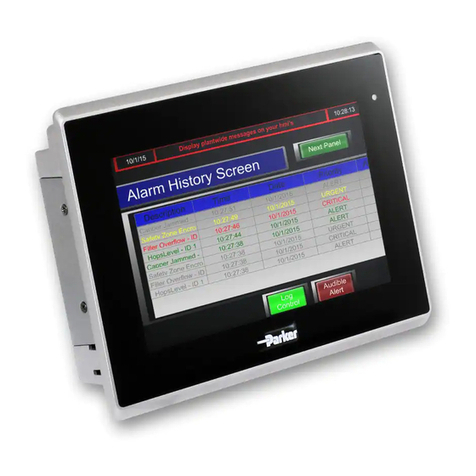
Parker
Parker PowerStation XT Series user manual
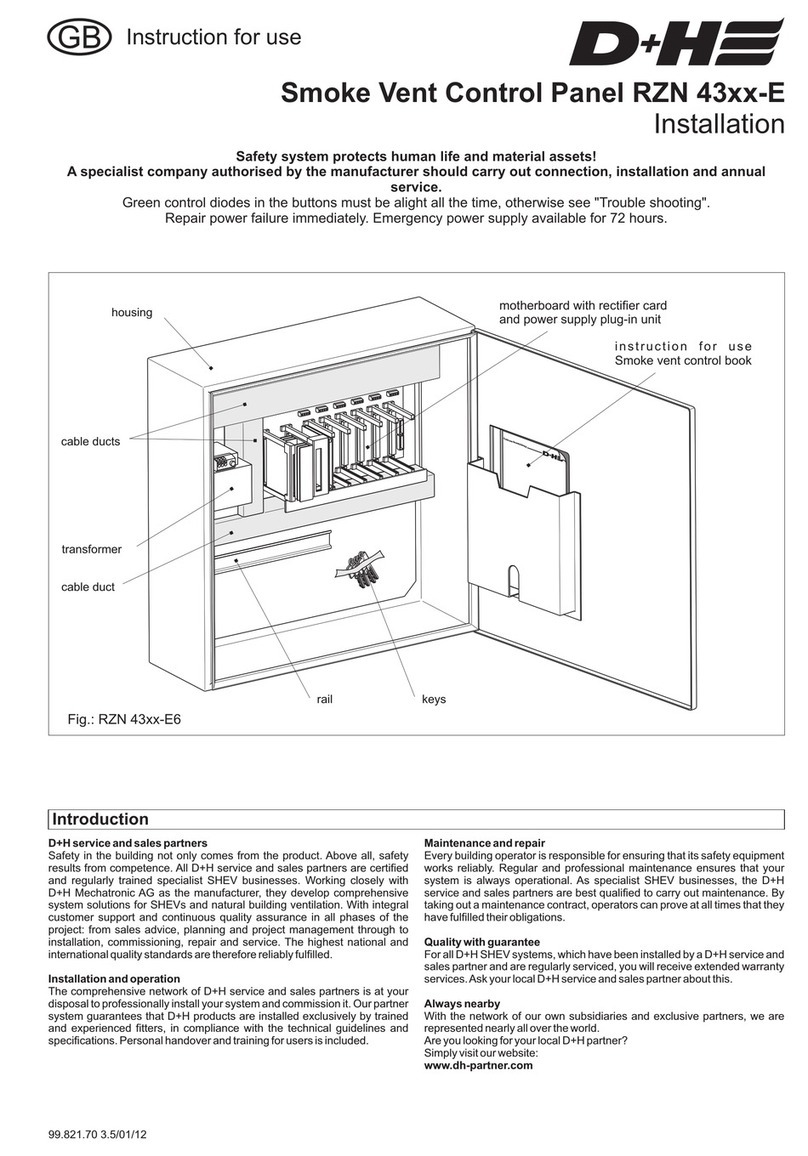
D+H
D+H RZN 43-E Series Instructions for use
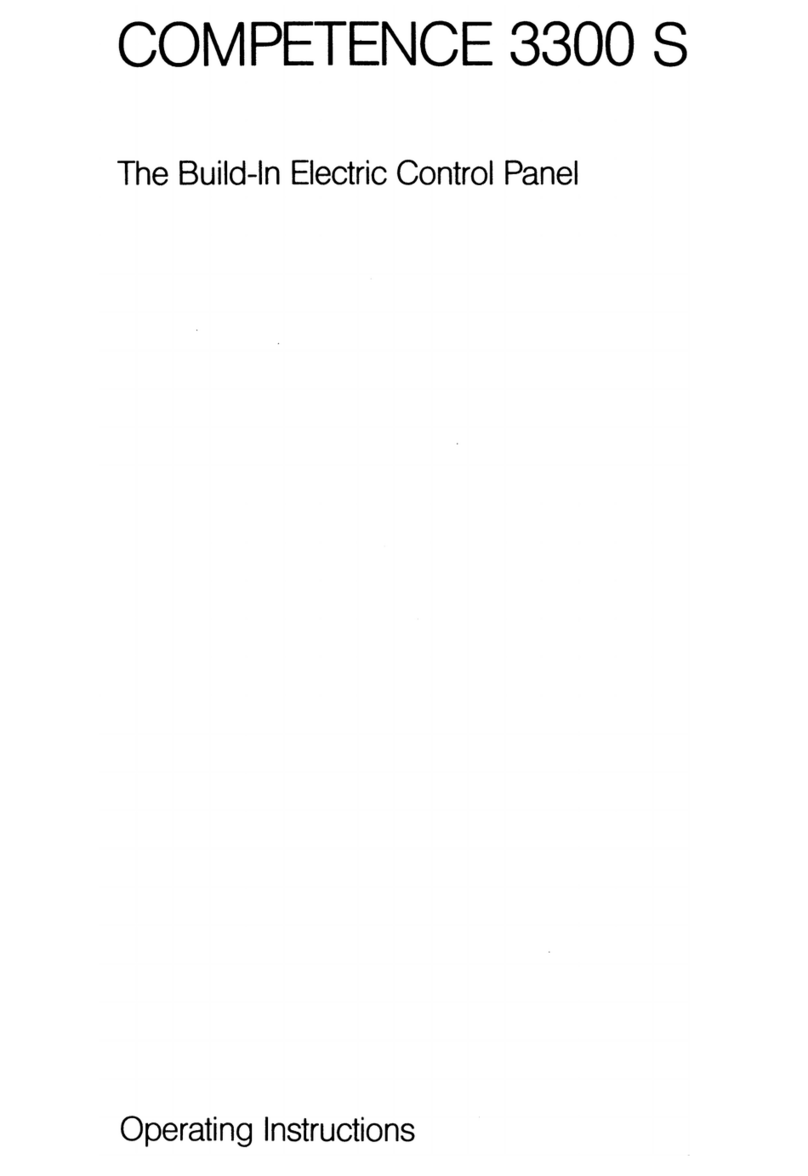
AEG
AEG COMPETENCE 3300 S operating instructions
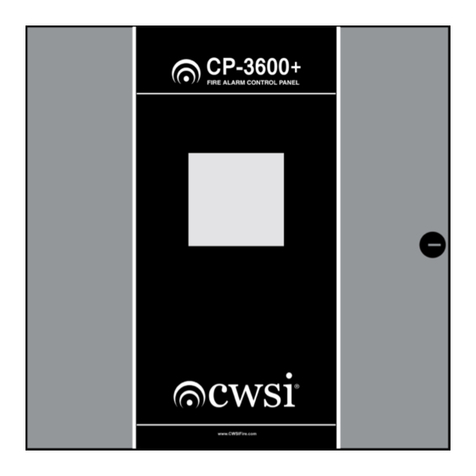
Tyco Fire & Security
Tyco Fire & Security CWSI CP-3600 Operating and installation instruction manual

CAME
CAME ZLX24SA installation manual
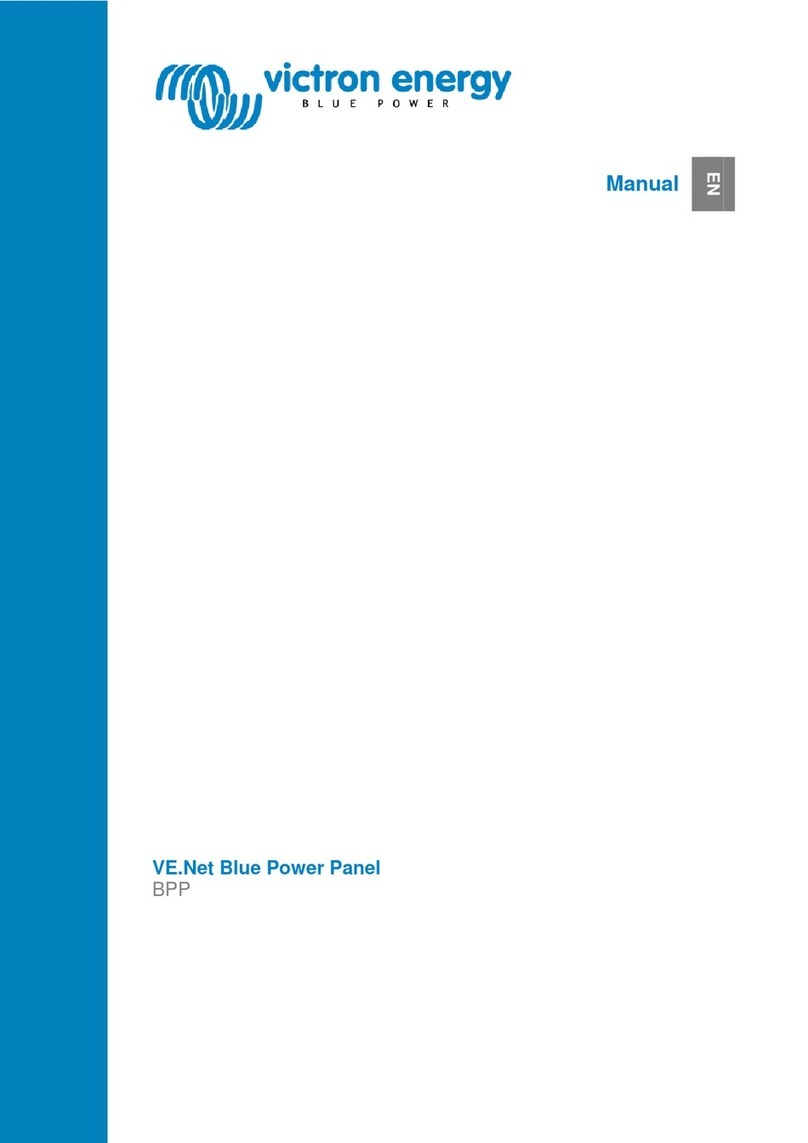
Victron energy
Victron energy VE.Net Blue Power Panel manual
